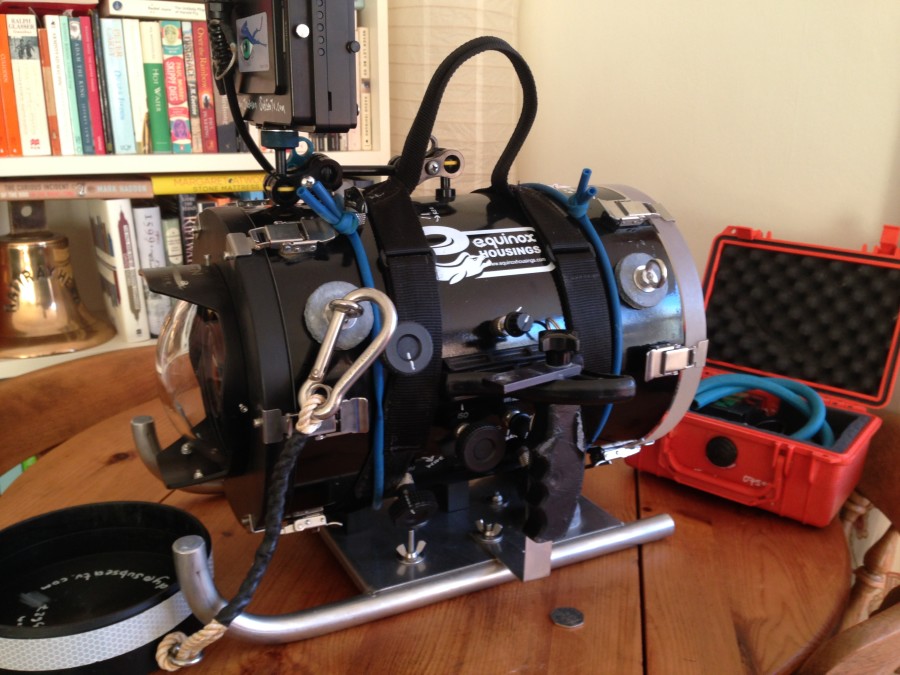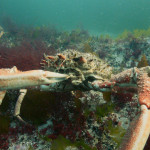Review of 2015: technical
Posted on February 16, 2016
In my last blog, I reviewed 2015’s filming and promised to share the technical highs and lows of my leap into the world of Ultra High Definition (UHD).
In January 2015, my new camera and housing arrived: a Sony PXW-FS7, my first interchangeable lens video camera, and an underwater housing from Equinox in the USA.
The PXW-FS7 is a superb camera. It produces a stunning UHD image with huge dynamic range. It’s taken me into the world of gamma curves, s-log, hypergammas and colour grading – a lot to learn. In UHD, focus is even more critical and s-log makes it harder to achieve with the washed out viewfinder image. A new high-resolution 7” monitor from Dive and See with focus magnification has made all the difference.
Taking such a magnificent camera underwater needed a housing I had utter confidence in. When the Equinox first arrived, the overall construction was bomb proof but I found the controls lacking, the stability poor, and the method of changing ports unworkable. I began a long process of customisation and, after a year of development, I now have a very slick, robust underwater housing. It has interchangeable Zen Ports for several lenses, a completely rebuilt system of controls, balanced distribution of weight through lead-filled skis and trim weights, resulting in perfect neutral buoyancy and a very stable platform for filming. Huge thanks to Rob Broadhead at HB Pressings for his brilliant problem solving, ideas, and engineering work. Thanks also to Dave Pennock for his help with many improvements and modifications, and to Mally Jenkinson for ski fabrication.
UHD files are enormous and require a high spec computer to process them, so I had to buy a new MacBook Pro – and lots of hard drives to backup all that data out in the field. It is now the running joke in the house – when the postman knocks, he is probably delivering another hard drive.
Investing in so much new kit was always going to create a step backwards before moving forwards – but it is necessary to keep ahead technically and I now find myself in full control again. The camera’s dynamic range and the wealth of colour information mean I can get the best out of all situations. The housing is now tailored to my needs and is a joy to work with underwater.
Huge thanks also to Nick Wilcox-Brown, Doug Anderson and Steve Trewhella for their advice about cameras and lenses.
I’m really excited about the filming opportunities lined up for me and my camera in 2016. Bring it on!
______________________
Images & words by Andy
Review of 2015’s diving and wildlife filmmaking
Posted on January 31, 2016
I’ve covered the UK in 2015: from Dorset to the Highlands, from Pembrokeshire to the Farnes. As usual, I’ve been filled with awe, experienced magical moments in nature, and groaned in frustration as the conditions and behaviour I want to film elude me. But that’s why I love being an underwater cameraman – and I’d love to share a few favourite moments…
One of my highlights was filming sea cucumbers in Loch Duich, which also proved to be one of the hardest locations. When sea cucumbers feed it’s mesmerising, like watching a beautiful ballet. They live on a soft muddy bank with little current and even less light. To get the shot, I had to set the camera directly above an animal on an underwater tripod – without disturbing anything. Each feeding sequence took a whole dive to setup and shoot. One wrong move and I would destroy the visibility with a thick cloud of silt, or I’d find that the sea cucumber had scarpered back into the mud.
On one dive, I’d finished the long setup without a hitch and set the camera rolling when a hermit crab came by and yanked on the sea cucumber’s feeding arm, causing the animal to retract out of sight. As it turns out, it’s a great behaviour shot, but I recall being less than pleased at the time.
In Dorset this summer, clear water was short-lived at Studland and my chance to film seahorses was limited. The few days I managed revealed a pair of lovely seahorses and a couple of surprise undulate rays.
The male seahorse was pregnant and I had hoped to film him up until he gave birth, but the wind changed, the waves rolled in, and the first and last bit of good visibility of the summer was gone.
Undulate rays have rarely been seen by divers, let alone filmed. It’s been suspected that Studland was a nursery because their spent egg cases are washed up on the beach in winter. These sightings support that theory and provide another good reason to make Studland an MCZ – as if there weren’t enough reasons already.
It was a great year for jellyfish. A boat trip with Steve and Julie got me in with several 6ft-long Barrel jellyfish near Kimmeridge. A shoal of horse mackerel lived with one of them – at one point they deserted their host thinking I was a better prospect but soon saw the error of their ways. In Pembrokeshire, after filming spider crabs, I had an end-of-dive dance with a beautiful Compass jellyfish in shallow water and extraordinary evening light.
My favourite moments this year were filming grey seals – above and below water. They rewarded my patience with behaviour I’ve never seen before. Interactions with them at the Farnes were incredible – a young female was all over me and my camera. She reminded me of my Cocker Spaniel, with the same sense of fun and mischief.
On land, I filmed seals at Ravenscar, a rugged Yorkshire spot I’ve known all my life and a special place of solitude for me. Not an easy location to get the camera gear as there’s a 600-foot climb between car and beach. Here I was rewarded with some beautiful morning light, mating sequences, and pup feeding, with a glimpse into just how vulnerable the seal pups are.
The biggest challenges of 2015 were probably technical – I upgraded my kit to 4k, which has created enormous learning across all aspects of my workflow. I’ll write a separate blog about that soon.
None of this would be possible without generous help from other people who are also passionate about wildlife. Thanks for all your help and advice, folks: Steve Trewhella, Julie Hatcher, Nick Wilcox-Brown, Matt Bjerregaard, Janet Ullman, Sue Scott, George Brown, Peter Cunningham, Lloyd Jones, Jake Finnigan, Doug Anderson, Neil Brock, Mally Jenkinson, Dave Pennock, Rob Broadhead and many others who have supported me this year in lots of ways.
Here’s a short film of 2015’s highlights. I hope you enjoy it.
______________________
British Wildlife Photography Awards: Wildlife in HD Video winner
Posted on September 14, 2015
We’re thrilled to share that our film The Last Seahorse in Studland? has won the Wildlife in HD Video category of the British Wildlife Photography Awards 2015.
Every year, we’re inspired by the beautiful photographs and films that tell dynamic, breathtaking, and intimate stories of Britain’s wildlife across all categories of the BWPAwards. It’s a great honour to have our work recognised amongst such talented company. Big congratulations to all the other category winners and commended entries.
We’re hopeful that winning the competition will bring more attention to the plight of British seahorses and help to protect one of our most iconic marine animals.
The exhibition is at Mall Galleries this week, or you can view all the winning and commended photos and films on the BWPA website.
Dorset’s Giants
Posted on September 12, 2015
It’s been a fantastic year for jellyfish; they’ve been reported regularly in high numbers across the UK.
After Andy’s dance with a Compass jellyfish a few weeks ago, he jumped at the chance to go jellyfish hunting in Dorset with friends Steve Trewhella and Julie Hatcher.
They searched the glassy sea, before chancing upon dozens of impressive Giant Barrel jellyfish, six feet long, a few with shoals of horse mackerel hitching a ride in their skirts.
Here are a few snippets of Andy being spun around the Lyme Bay dance floor by giant beauties.
______________________
Images by Andy, words by Jackie
Highland’s Hidden Homes
Posted on August 29, 2015
We’re excited to share a new short film we’ve been working on with the Highland Seashore Biodiversity Project and talented musician and composer, Mairearad Green.
Highland’s Hidden Homes aims to enthuse all age groups about the diversity of life in the shallow waters of the Highlands. It’s colourful and captivating with a vibrant musical score. We built the narrative around the theme of Scottish hospitality, exploring which sort of homes – and welcomes – we might find underwater.
The film premièred at the Summer Isles festival in Coigach on 29th August; there was “standing room only and a big round of applause”, said Janet Ullman, Highland Seashore Project Coordinator.
It’s been a privilege for SubSeaTV to be part of this project, giving people a glimpse of the underwater world that we love so much.
We hope you enjoy the film!
Images by Andy, words by Jackie
With thanks to our partners: The Highland Seashore Biodiversity Project, Mairearad Green, Scottish Natural Heritage, The Highland Council, The Heritage Lottery Fund, and The Crown Estates.


